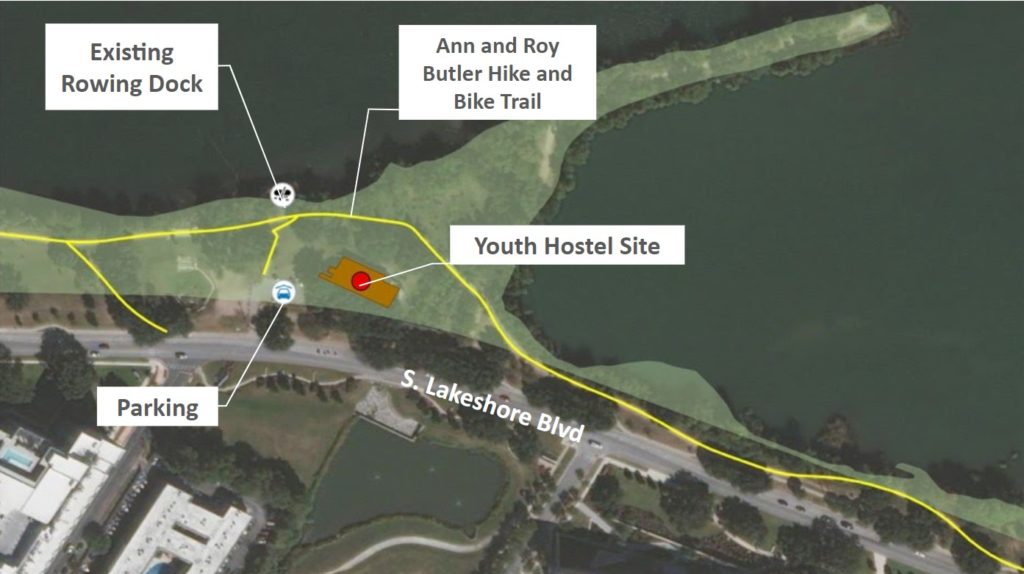PARD details the search for a new home for a newish boathouse
Friday, January 14, 2022 by
Amy Smith It’s not every day that 300 people show up for a local webinar, but when a future rail system threatens to collide with a popular rowing center and cafe, community members tend to take note.
The occasion in this case was a community engagement forum on Wednesday that was part of City Council’s direction to staffers to search for a new home for the boathouse operated by the Austin Rowing Club.
The forum included a presentation by Peter Mullan of the Austin Transit Partnership on the proposed route of the Blue Line – from Republic Square to the airport – followed by the Parks and Recreation Department’s analysis of six potential sites that could accommodate a 7,000-square-foot building along the lake.

The leading alternative site, on South Lakeshore Drive
The city built the existing boathouse at 74 Trinity St. to make way for the Waller Creek tunnel project. Now the boathouse again stands in the way of progress. As the Austin Monitor reported last month, a vacant youth hostel on city property at 222 S. Lakeshore Blvd. appears to be the most feasible of the six possible relocation sites. The hostel closed permanently in 2020 due to the Covid-19 pandemic. The building’s location is east of Interstate 35, and as Parks and Recreation Department Assistant Director Liana Kallivoka pointed out, the east side site would help alleviate the congested watercraft areas west of I-35.
Kevin Reinis, executive director of the Austin Rowing Club, told the Monitor his first preference would be for the relatively new boathouse and Alta’s Cafe to stay at its existing home, but he acknowledges there is little likelihood of that happening. “My kind of dream vision would be that the boathouse and the services and the amenities that we offer the public can be reconstituted in some form at or near the current location,” he said. “That may not be possible because it’s a very complex site for the Project Connect team.”
Reinis credited the parks department and Council Member Kathie Tovo for their work on locating a new site and ensuring the community has a say in the process.
PARD analyzed the five other sites, listing their pros and cons:
- An existing rowing dock concession in Zilker Park, west of the MoPac Expressway bridge. The location is a former landfill and would require remediation. The site “might be risky and complicated” due to the ongoing Zilker Vision Plan process and the Central Texas Regional Mobility Authority’s plans for MoPac South.
- A location east of the MoPac bridge and across the lake from the Texas Rowing Center. The site would face the same challenges stated above.
- A PARD ballfield used by Austin High School through an agreement with AISD. Relocation to the site would require a search for another ballfield. Its proximity to the Texas Rowing Center would likely create more watercraft congestion than already exists.
- A site near the Rainey Street area that is very close to the existing boathouse. This location already appears to be off the table due to parkland improvements currently in the permitting phase and continuing high-rise construction in this area.
- A location within the Holly Shores/Edward Rendon Sr. Park at Festival Beach. This site, too, appears to be a nonstarter because the Council-adopted vision plan for the park does not include a rowing facility and would require extensive community outreach, board and commission input, and an amendment to the plan.
With all of the downsides of the five sites daylighted for the public, this leaves the sixth site – the former hostel location – as the most attainable should PARD choose to pursue the location as a watercraft concession.
Reinis likes the hostel site, noting ironically that it was once home to the organization, which has had to move several times over its 40-year history. He said the number of attendees at Wednesday’s forum illustrates how much the community values the boathouse.
“I was frankly humbled by how well and how strongly our community responded in raising the profile of this issue, because it was just going to be destroyed. What you saw was an expression of people not wanting to see that it not be, dare I say, blown out of the water.”
The Austin Monitor’s work is made possible by donations from the community. Though our reporting covers donors from time to time, we are careful to keep business and editorial efforts separate while maintaining transparency. A complete list of donors is available here, and our code of ethics is explained here.
You're a community leader
And we’re honored you look to us for serious, in-depth news. You know a strong community needs local and dedicated watchdog reporting. We’re here for you and that won’t change. Now will you take the powerful next step and support our nonprofit news organization?





